Around Dilsberg
Above Neckargemünd to the right before the hamlet of Rainbach, gleam huge red quarry walls. And then the steep Dilsberg is before us, an old mountain fortress still crowned with a village surrounded by the town walls. From this side the best way to reach it is via Rainbach, and then we stand above in front of a pretty old gateway and can saunter through the small village with its narrow alleyways and the little houses often perched on the town walls. At the highest point we come to the still unusually impressive remains of the one-time Dilsberg Fort. The tower and huge wall with its fortified galleries, from whence there is a splendid view, are open to visitors. The battle strength of this old fortress, often stormed in vain in past centuries, still speaks to us from the ruins. Tilly, too, the famous imperial general, once had to retreat from here without success.
From Dilsberg we look down on Neckarsteinach at the bend in the river, stretched out between the splendour of its forts. It has four forts of its own and also the view of Dilsberg with the fifth fort in the circle! The four forts lie next to one another as though on a string: closest to the little town the Vorderburg with only a few walls left, hardly visible between old trees, then the Mittelburg, magnificently restored and inhabited by descendants of the Steinach knights, with towers and battlements, not far away in the bend the extensive ruins of the Hinterburg, probably the strongest of them all, and finally, high up on the slope like a bird's nest, the ruins of Fort Schadeck, popularly called "The Swallows' Nest". The inhabited castle cannot be viewed, but it is well worth while to climb up to the Hinterburg and the Swallows' Nest, especially on account of the splendid view of the Neckar Valley. The dynasties of Steinach had their seat here from the 12th to the 17th centuries and for a long time bore the name of "Landschaden von Steynach” — "Land Ravagers of Steynach" — and it is still not sure whether this name was bestowed on them in honour or dishonour. Their Gothic tombstones in the loth century church are very remarkable. One of these knights, Hans Bligger von Steinach, who lived about the turn of the 12th and 13th centuries, was well-known as a minnesinger. The famous great Heidelberg “Lieder" manuscript contains three "lieder” or songs by him besides his “picture". In Neckarsteinach itself we enjoy the sight of several find framework houses and other buildings of special character which are well worth seeing. Formerly, when once again fencing with sabres was forbidden in Baden, the Heidelberg students came to Hesse to fight their duels, which were not forbidden here.
In summer there is a lively boat traffic an the Neckar up to Neckarsteinach, sometimes going on to Hirschhorn or Eberbach. On the other hand, since the sluices have been built, the passenger boats which plied for many decades between Heilbronn and Heidelberg, have now disappeared, nor are the wooden rafts to be seen any more. However, the numerous locks, keeping the water in the Neckar at a steady level, have greatly promoted cargo-shipping far into Württemberg and it is now possible for ships up to 1.200 tons to go up and down the river. Both before and after the first world war there was lively "water wandering” on the Neckar with paddleboats and punts, but this is now restricted. In those days the boatmen either packed their boats together and then went a considerable distance up the Neckar by train in order to float downstream in their little boats, or on Fridays that had their boats towed by the chain tugs to Neckargerach or Wimpfen and could then come back to Heidelberg on Sundays — if the water level was favourable probably without a stroke of the oar or paddle.
Navigation on the Neckar is very old and was probably carried on by the Romans, who supplied their military establishments in the Neckar district in this way and apparently also carried on merchant shipping to a small extent. Later a “Neckar Valley Boatmen's Fraternity”, as a sort of guild, supervised navigation. The first steamship went up to Heilbronn in 1840 and as early as 1841 steamships plied regularly down stream from there. For many decades the barges were drawn by chain tugs which were reeled along on the bed of the Neckar, 80 Miles from Mannheim to Heilbronn. But these "Neckar donkeys" stopped operating when the canalization of the Neckar was started a few years after the first world war. In our time the Neckar barges chiefly carry coal, iron, timber, sand, gravel, grain, cement, scrap, oil and fertilizers, the upstream traffic carrying by far the largest volume of transports.
But the other traffic, too, along the Neckar has changed greatly in the last decades by the increase of motor cars. The number of strangers visiting the Neckar Valley by car, sometimes resting and camping on the banks and bathing hi the river, is especially large in the hot summer months and at the weekends. Then the banks in some places are full of tents from Heidelberg far up the valley. Besides, there come the swarms of cyclists and wanderers, the gaily waving passengers on the passing ships, so that on fine Sundays there is a cheerful and carefree life on the Neckar, most lively, of course, near the larger towns.
From Dilsberg we look down on Neckarsteinach at the bend in the river, stretched out between the splendour of its forts. It has four forts of its own and also the view of Dilsberg with the fifth fort in the circle! The four forts lie next to one another as though on a string: closest to the little town the Vorderburg with only a few walls left, hardly visible between old trees, then the Mittelburg, magnificently restored and inhabited by descendants of the Steinach knights, with towers and battlements, not far away in the bend the extensive ruins of the Hinterburg, probably the strongest of them all, and finally, high up on the slope like a bird's nest, the ruins of Fort Schadeck, popularly called "The Swallows' Nest". The inhabited castle cannot be viewed, but it is well worth while to climb up to the Hinterburg and the Swallows' Nest, especially on account of the splendid view of the Neckar Valley. The dynasties of Steinach had their seat here from the 12th to the 17th centuries and for a long time bore the name of "Landschaden von Steynach” — "Land Ravagers of Steynach" — and it is still not sure whether this name was bestowed on them in honour or dishonour. Their Gothic tombstones in the loth century church are very remarkable. One of these knights, Hans Bligger von Steinach, who lived about the turn of the 12th and 13th centuries, was well-known as a minnesinger. The famous great Heidelberg “Lieder" manuscript contains three "lieder” or songs by him besides his “picture". In Neckarsteinach itself we enjoy the sight of several find framework houses and other buildings of special character which are well worth seeing. Formerly, when once again fencing with sabres was forbidden in Baden, the Heidelberg students came to Hesse to fight their duels, which were not forbidden here.
In summer there is a lively boat traffic an the Neckar up to Neckarsteinach, sometimes going on to Hirschhorn or Eberbach. On the other hand, since the sluices have been built, the passenger boats which plied for many decades between Heilbronn and Heidelberg, have now disappeared, nor are the wooden rafts to be seen any more. However, the numerous locks, keeping the water in the Neckar at a steady level, have greatly promoted cargo-shipping far into Württemberg and it is now possible for ships up to 1.200 tons to go up and down the river. Both before and after the first world war there was lively "water wandering” on the Neckar with paddleboats and punts, but this is now restricted. In those days the boatmen either packed their boats together and then went a considerable distance up the Neckar by train in order to float downstream in their little boats, or on Fridays that had their boats towed by the chain tugs to Neckargerach or Wimpfen and could then come back to Heidelberg on Sundays — if the water level was favourable probably without a stroke of the oar or paddle.
Navigation on the Neckar is very old and was probably carried on by the Romans, who supplied their military establishments in the Neckar district in this way and apparently also carried on merchant shipping to a small extent. Later a “Neckar Valley Boatmen's Fraternity”, as a sort of guild, supervised navigation. The first steamship went up to Heilbronn in 1840 and as early as 1841 steamships plied regularly down stream from there. For many decades the barges were drawn by chain tugs which were reeled along on the bed of the Neckar, 80 Miles from Mannheim to Heilbronn. But these "Neckar donkeys" stopped operating when the canalization of the Neckar was started a few years after the first world war. In our time the Neckar barges chiefly carry coal, iron, timber, sand, gravel, grain, cement, scrap, oil and fertilizers, the upstream traffic carrying by far the largest volume of transports.
But the other traffic, too, along the Neckar has changed greatly in the last decades by the increase of motor cars. The number of strangers visiting the Neckar Valley by car, sometimes resting and camping on the banks and bathing hi the river, is especially large in the hot summer months and at the weekends. Then the banks in some places are full of tents from Heidelberg far up the valley. Besides, there come the swarms of cyclists and wanderers, the gaily waving passengers on the passing ships, so that on fine Sundays there is a cheerful and carefree life on the Neckar, most lively, of course, near the larger towns.
Dieses Kapitel ist Teil des Buches The Neckar Valley. From Heidelberg to Wimpfen
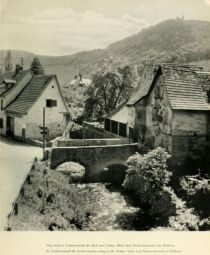
017 Eilig läuft in Neckarsteinach der Bach zum Neckar. Blick über Neckarsteinach zum Dilsberg
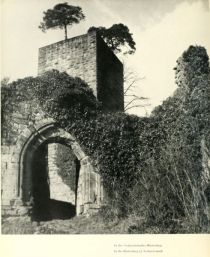
018 In der Neckarsteinacher Hinterburg
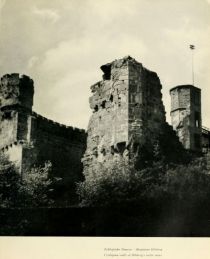
019 Zyklopische Mauern - Burgruine Dilsberg
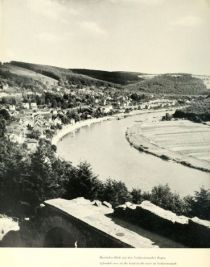
020 Herrlicher Blick auf den Neckarsteinacher Bogen
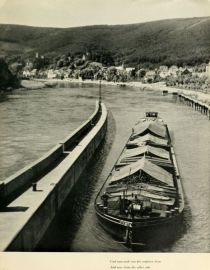
021 Und nun noch von der anderen Seite
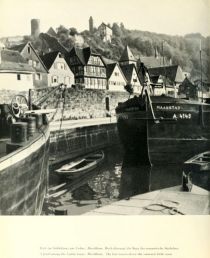
022 Perle im Städtekranz am Neckar - Hirschborn. Hoch überragt die Burg das romantische Städtchen
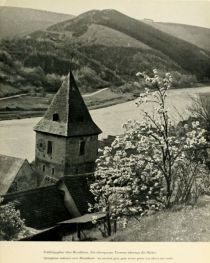
023 Frühlingsglanz über Hirschborn. Ein altersgrauer Torturm überragt die Dächer
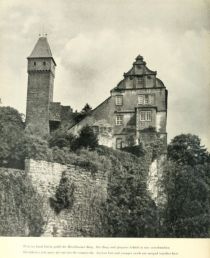
024 Weit ins Land hinein grüßt die Hirschhorner Burg.
alle Kapitel sehen